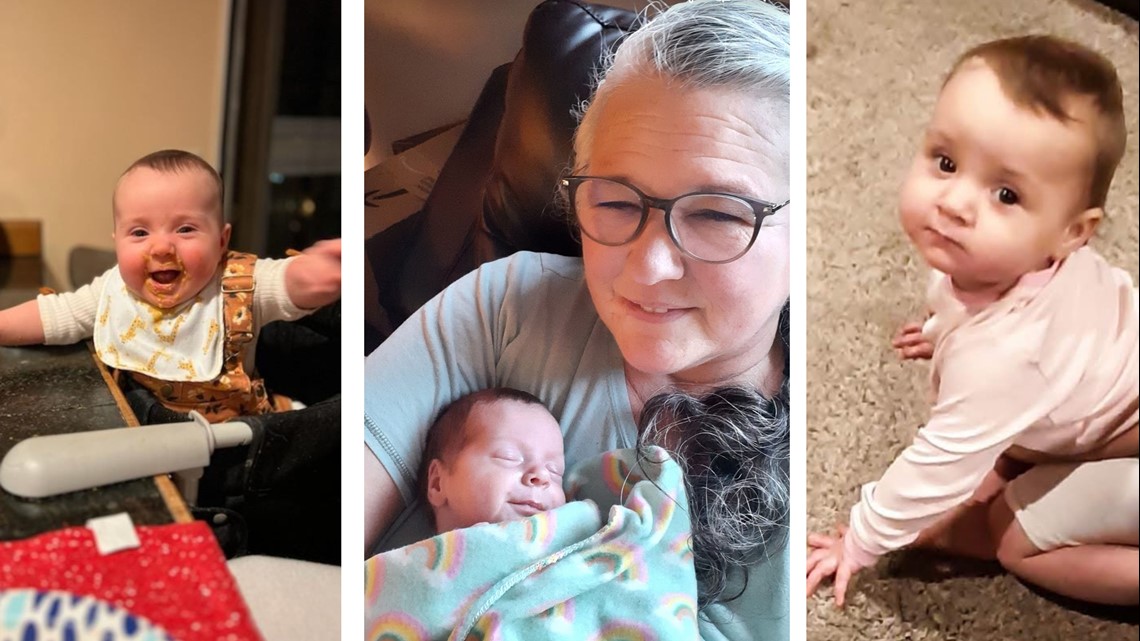BURLINGTON, Wash. — The grandmother of a Snohomish County child who died of suspected fentanyl exposure accuses the Washington State Department of Children, Youth and Families (DCYF) of not doing enough to protect the young girl, as a new state law raising the standard for removing children from a home is poised to take effect.
Avril, 1, died in early May after Danette Scott says she worked for months to get the state to remove Avril from the care of the baby's mother, who was using fentanyl.
According to the Snohomish County Sheriff’s Office, Avril was staying with her 37-year-old mother on May 7 in an Everett hotel room, where “fentanyl was being smoked” when the child became unresponsive. Detectives believe fentanyl exposure likely led to her death, though toxicology reports are pending.
“There was a clear path to protect this child and keep this baby alive,” said Scott, who called Child Protective Services (CPS) in December after she said she observed Avril’s mother smoking fentanyl around her grandchild.
“I needed somebody to help me make sure that the baby was safe," Scott said. “What good did CPS do? Nothing. They didn't do anything to help this child.”


Avril’s mother, who Snohomish County detectives said is a suspect in the “suspicious death” investigation, declined an interview request. KING 5 is not naming her because she hasn’t been charged with a crime.
A KING 5 review of DCYF records revealed Washington state child welfare workers were involved with the family in the months prior to Avril’s death. In March – less than two months before the child died – DCYF closed its case while recognizing Avril’s mother continued to battle fentanyl addiction.
The social worker shared resources for treatment options and urged the child’s mom to “think of Avril’s safety” if she “chose to use” the “extremely dangerous” drug, according to a copy of the CPS closure letter provided to KING 5 by Scott.
“You know that she’s using fentanyl and you just leave the baby with her? How is that supposed to be safe?” said Scott, who hoped she could get temporary custody of the child until her daughter got clean. “Shock just turned to just fury and I couldn’t even believe it.”
Medical toxicologists say even a small amount of fentanyl can be lethal to children, as the drug is 50 times stronger than heroin and 100 times more potent than morphine.
Since January 2022, fentanyl-related incidents nearly killed at least 38 youth who had prior contact with the state’s child welfare system, according to May 18 data from the Washington State Office of the Children And Family Ombuds. At least 18 Washington kids died from fentanyl-related incidents in the same timeframe, the data shows.
It’s unclear what factors led DCYF to end its involvement with Avril’s case or what actions the state took prior to closing it.
Jason Wettstein, a DCYF spokesperson, said the agency is unable to comment on the situation, but the department will conduct a formal review of Avril’s death.
New state law tightens criteria for removing children
In cases like Avril’s, where parental substance use is flagged as a concern, child welfare experts said caseworkers can only do so much. DCYF does not have the authority to independently remove children from homes. It’s up to local law enforcement and courts to make those decisions.
A new state law, which passed the legislature in 2021, tightens the criteria for removing a child from their parent. It significantly changes how the state’s child welfare workers can respond to allegations of abuse and neglect, and it makes it mandatory for them to consider preventive services for families.
In order to remove a child from his or her parent, the “Keeping Families Together Act'' requires caseworkers to prove to the courts that the risk of “physical harm” to the child is imminent. The previous standard made child welfare workers prove a “serious threat of substantial harm.”
The law also prevents the state from removing children because of certain conditions in the home – including substance use – unless there is a specific connection to imminent physical danger. Inadequate housing, domestic violence and a parent’s mental illness are also not sufficient reasons alone.
“I think that it will leave children at greater risk in some circumstances. But then I also recognize there's the balance with, ‘what's the harm by removing children at times unnecessarily when they could have remained in the home?’" said Patrick Dowd, director of the Washington State Office of the Children And Family Ombuds. “There's constantly that tension between family support and preservation and child protection that is inherent in the system.”
Dowd said the intention of child welfare advocates and lawmakers who supported the policy change was to recognize the trauma of removing a child from the home and the child welfare system’s disproportionate adverse impacts on poor, Black and Indigenous families.
‘We’re just drowning’
The law officially takes effect on July 1, but child welfare workers said many judges across the state have already been operating under the new rules.
Jeanette Obelcz, a CPS supervisor and the chair of a statewide policy committee for the union that represents thousands of DCYF employees, said that while she supports the intent of the new law, she and her coworkers have begun to see harmful, unintended consequences.
“We’re already seeing children return to situations that we firmly believe are unsafe, and without enough protection in place to keep those children safe,” said Obelcz, speaking in her capacity as a member of the Washington Federation of State Employees. “I’m very worried that the kids are going to be seriously harmed, or even die.”
Obelcz said the policy change has led some DCYF staff to leave the agency because they no longer feel confident that they can protect vulnerable children.
“We’re just drowning,” she said.
Obelcz described how high caseloads and a lack of resources make it difficult for social workers to gather what they need to prove to the court that there’s an imminent physical risk. She said she’s also worried that the change forces DCYF to be reactive in situations that should be treated with urgency.
“Because there needs to be this risk of imminent physical harm, chronic neglect gets incredibly minimized,” she said. “We’re waiting for something to happen, as opposed to being able to act preemptively based on all of the knowledge that we have around substance abuse and parenting vulnerable children.”
Dowd, the DCYF ombuds, said his office will keep close tabs on the impact of the new law and its effect on child safety – recognizing there’s a gap in essential resources to effectively carry out the law’s intent.
“Until we have that robust system of services and support available, we will have situations where CPS or law enforcement or the courts don’t have the legal threshold to take action,” he said. “Does that mean they think everything is fine? No. And they probably share the same concerns as does the person that made that call to CPS.”
Wettstein, the DCYF spokesperson, also called for additional services once the law fully goes into effect.
“There will be an even more urgent need for substance abuse treatment in all regions of the state,” he wrote in a statement. “Such services must be available at the moment a parent is ready to enter into treatment.”
Dowd said his staff will continue to track how the fentanyl crisis is affecting the children who’ve had involvement in the state’s child welfare system. He said he believes the state should give fentanyl-related cases more weight when assessing safety threats to kids.
“The type of drug that is being used by a parent is significant and needs to be considered in making that assessment of whether or not there is imminent physical harm to a child that would justify removing the child from a parent’s home,” he said. “We do need a different approach to working with families where fentanyl is a significant issue.”

